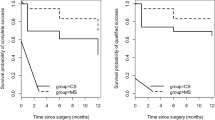Summary
Background: We perform partial sphincterectomy during cataract surgery in cases with very small pupil (< 3 mm). We assume that the small pupil is mainly due to a fibrosis ring of the sphincter muscle.
Patients: In 35 patients we performed the complete ophthalmological routine check-up. The pupil diameter was analysed by perimeter: a base value, with light, and in pharmaceutical mydriasis. Moreover 15 preparations were analysed histologically.
Results: Average pupil diameter was: base value 3.76 mm, with light 3.24 mm, in pharmaceutical mydriasis 4.84 mm. The showed pathohistological examination that in all excisions a part of the sphincter muscle was verifiable. We found fibrosis of different grades in various locations.
Conclusion: In most cases functional pupil movement can be verified after operation. In an intended partial sphincterectomy part of the sphincter muscle can be excised. The different pupil diameter is due to the different degree of fibrosis of the sphincter muscle.
Zusammenfassung
Fragestellung: Die partielle Sphinkterektomie wird bei uns im Rahmen der Kataraktchirurgie bei sehr enger Pupille (< 3 mm) praktiziert. Wir nehmen an, daß die enge Pupille hauptsächlich durch einen Fibrosierungsring des M. sphincter pupillae bedingt ist.
Patienten und Methode: Wir untersuchten 35 Patienten komplett ophthalmologisch. Es wurden mit Hilfe des Okulars am Goldmann-Perimeter die Pupillendurchmesser ermittelt: Basiswert, unter Lichteinwirkung und nach medikamentöser Mydriasis. 15 Exzisate wurden zusätzlich histologisch bearbeitet.
Ergebnisse: Eine durchschnittliche Pupillendifferenz als Basiswert betrug 3,76 mm, bei Licht 3,24 mm, in medikamentöser Mydriasis 4,84 mm. Die pathohistologische Untersuchung ergab, daß in allen Exzisaten Muskelanteile des Sphinkters nachweisbar waren. Die Fibrose war in unterschiedlicher Stärke und Lokalisation nachweisbar.
Schlußfolgerung: Bei der intendierten partiellen Sphinkterektomie kann in der Tat ein Teil des M. sphincter exzidiert werden, wonach in den meisten Fällen die funktionelle Pupillomotorik postoperativ nachgewiesen werden kann. Die unterschiedliche Pupillengröße ist durch das jeweilige Ausmaß des Fibrosierungsgrades des Sphinktermuskels bedingt.
Similar content being viewed by others
Author information
Authors and Affiliations
Rights and permissions
About this article
Cite this article
Pham, D., Volkmer, C., Leder, K. et al. Partial sphincterectomy in cataract surgery. Clinical and pathohistological results. Ophthalmologe 95, 635–638 (1998). https://doi.org/10.1007/s003470050327
Published:
Issue Date:
DOI: https://doi.org/10.1007/s003470050327




